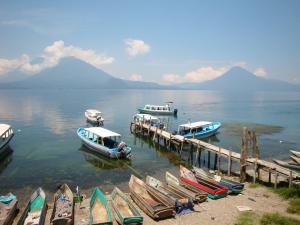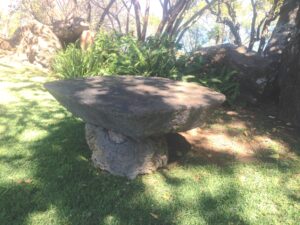Lake Atitlán
The Heart of the AmericasYou can’t leave Lake Atitlán without your heart being transformed.
Lake Atitlán is located in the heart of the Americas and is one of the most beautiful lakes in the world. Atitlán is a local Nahuatl (pronounced Nahwal) word and translates to – at the waters. The lake is situated in the Guatemalan Central Highlands. It is the deepest lake in Central America, because the lake itself is a volcano crater and is resplendently surrounded by a ring of volcanos.

Photo by the author: view from the centre of the lake showing Cerro de Oro, which is small extinct volcano and in front of Toliman volcano on the southern shores of the lake. I was told by a local that when the Spanish first came to Lake Atitlán, they looked for gold hidden in the caves and tunnels under Cerro de Oro, they got lost and never returned. You can hike up Cerro de Oro with a local guide and not get lost.
As you descend the windy roads leading to the lake, a sublime view of saphire coloured waters greets you and a rainbow of coloured vegetation along the side of the lake. The cloud laden volcanos sometimes form disc-like shapes. Photographs just don’t do this area justice. When the mist rises from the lake, it has an incredible ethereal feel. It’s hard not to be enchanted by the views across the lake at night, fairy light-like villages can be seen twinkling along the shores. The whole lake area has a peaceful vibe and this is the reason it is a magnet for those seeking to embody serenity into their lives. Lake Atitlán has an energy vortex with many thin places dotted around the lake. So it is little wonder that this is a sacred place to the Maya and it has always been.

Photo: view from Santa Catarina dock.
Lake Atitlán is the heart of Guatemala, the heart of Central America and also the heart of the Americas.
With all this heart energy you just can’t help falling in love with this area. The heart was very important to and symbolic for the ancient Mayan culture. In fact, the Mayans considered that there were seven aspects of the heart: love, compassion, intuition, kindness, faith, gratitude and humbleness. The heart is integrated into the local language. Mayans don’t ask you how you are? (¿como estas?) instead they ask, what is your heart telling you? A Spanish verb was created to exemplify this; corozonar, which translates as listen to your heart.
Beneath the waters towards the south of the lake, there lies an ancient city. In the late 1990s scuba divers found an underwater ceremonial site which was given the name Samabaj. Guatemala’s Atlantis, if you will. It has been speculated that the site is reminiscent of the place of the Mayan creation story. Remarkably, they found detailed carvings and intact pottery pieces with colours that hadn’t faded.
Researchers believe that Samabaj was an island before a catastrophic event happened. Volcanic eruptions and landslides occur here every few years, which raise water levels. So it is likely that this happened to the ancient site. Many of the artifacts found are housed in the Museum Lacustre Atitlán, Hotel Posada de Don Rodrigoin in Panajachel. It could be considered a blessing that the catastrophe happened before colonisation by the Spanish, who destroyed or looted precious artifacts across the region.
Lake Atitlán, has no outlets for the water. Over time the water levels change in the lake; rising and falling. Along the shores, many buildings can be seen which are underwater. I loved the thermal spring vents close to the shoreline at Santa Catarina Palopó which were easily accessible in 2010, but these are now found deeper down in the water. The property I used to visit had buildings we meditated in, which sunk under water the very next year. Unfortunately, locals are more tragically affected by landslides, because their houses are built on the steep embankments above the lake.
Various ritual sites can be found in caves and on plateaus above the lake. Back in 2010, whilst clearing scrub high above the waters on their land, the owners of the property I stayed on discovered a Nahuatl carved stone head and a disused ancient ceremonial site. Word got out to elders in the Mayan community and priests would turn up discretely to conduct ceremonies. Mayan elder Priests stay below the radar for safety after spiritual leaders were murdered in times of political unrest and misinformed accusations of them practicing witchcraft. I was fortunate to be there on a few occasions when elders spontaneously arrived and would invite us to do ritual with them.

Photo: Mayan ceremonial altar.
Heading towards 2012, when a new ba’ktun, (cycle of time) was soon to commence, 11/11/2011 was an auspicious date. We planned on doing a ceremony that day. Before the ceremony was due to happen, some men in traditional Mayan dress canoed to the property and proceeded up to the ceremonial site. As I walked up the to the top of the steps, one of these men greeted me in silence with the most loving eyes I had ever met. I melted as we held gaze and my heart centre expanded.
As soon as I stepped on the ceremonial ground, I entered a trance state and continued to feel that loving energy in my heart centre throughout the ceremony. Mayan rituals require the participant to initiate a connection from their heart with nature, invoking the heart of the winds, the waters, the trees and the ancestors. The group made offerings to the central fire including tobacco, sugar, incense, alcohol, flowers and candles, as the men chanted in their native language. They acknowledged the local towns and surrounding volcanoes. Their prayers were transported away with the fire’s smoke. As a violent wind picked up, I began to feel discombobulated, breathing gently into my heart I returned to an ordinary state. The man that greeted me declared that the ceremony had involved creating a bridge uniting north and south America and clearing instability to connect with imox (pronounced imosh) which is the great ocean of consciousness in the Mayan tradition. He placed his hands on my cheeks and repeated imox.
Like Bali, unfortunately Lake Atitlán has succumbed to mass spiritual tourism and you’ll find some interesting offerings and whispers of cosmic vibrations. Irrespective of the commercialisation, San Marcos is a great place to visit and you’ll find a plethora of spiritual traditions and activities. Not to mention great cafés with vegetarian/vegan food, which was hard to find in years gone by. Cacao is a wonderful heart opener. Ask around, you may perhaps even find an authentically Mayan facilitated cacao ritual.

Photo: ethereal view of the lake from the hinterland of San Marcos Kawok Forest Retreat.
Lake Atitlán can be reached by taxi or colectivo from the beautiful, colonial town Antigua (also a great place to visit) or from Guatemala city. Once, the area was affordable but prices have increased dramatically. Do be warned the villagers love to party on feast days with exceedingly loud music and fireworks throughout the night.

Photo: brightly coloured local houses. Since this photo was taken by the author a community project which involved painting more houses around Santa Catarina with brightly coloured native designs, has been completed.
